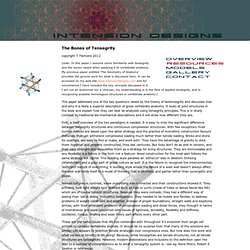

Download the article. Anatomy-trains.png 1 014 × 1 391 pixels. Notes on Anatomy and Physiology: Slings at the Front, Slings at the Back. For awhile now, we’ve been delineating hand to foot continuities that run throughout the body, providing strength, flexibility and a more developed sense of one’s body in space as they unfold.

These patterns of uninterrupted flow, created by sequences of muscle, tendon, fascia and bone, come and go with movement. We saw, last time, how motion of the hands helps create lines of pull that travel by various routes up into the torso. Our task today is to look for some of the strings that will convey these impulses from the torso down into the pelvis, legs and feet. Back of the torso A good place to start is at the back of the trunk.
The next two drawings provide an overview of what Myers calls the Back Functional Line. Fig 1 The Back Functional Line. Fig 2 Diane Lee refers to this same line as the posterior oblique sling. If we had started with the right latissimus, we would have ended up at the left tibia. Fig 4 A view of the posterior aspect of the right gluteus maximus. Img_0240.jpg 1 225 × 2 949 pixels. Img_0145.jpg 1 546 × 2 990 pixels. Anatomy Trains Introduction. A Tour of the Spiral Line. The Shoulders and the Spiral Lines Clip. kennethsnelson.net/Tensegrity_and_Weaving.pdf. Intension designs - the geometry of anatomy. Among clinicians and bodyworkers today, there appears to be a great deal of interest in the concept of tensegrity as it applies to living forms, but much confusion as well.

In some circles it seems to be the flavour of the decade but what are they talking about? What exactly is a tensegrity? Is it a useful scientific description and explanation for anatomical function? Or is it just a metaphor for the intuitive feeling that bodies behave as whole systems held in connective tension? If the latter, it’s as good or better than any other analogy and the definition can remain vague. I’m not an anatomist, a biomechanist, or a body worker. Quite a mouthful, but put this way, I can focus on the geometry of the body and speculate on how and if, it is composed of patterns identifiable as tensegrities. My tensegrity models are abstractions of the body designed to approximately diagram forces and movements that act on anatomical structure. Fig 1. Tensegrity is... How does Fuller define it? Intension designs - the geometry of anatomy. Copyright T.

Flemons 2012 (note: In this paper I assume some familiarity with tensegrity and the issues raised when applying it to vertebrate anatomy. My previous paper entitled ‘The Geometry of Anatomy’ provides the ground work for what is discussed here. It can be accessed on my web site www.intensiondesigns.com and for convenience I have included the key concepts discussed in it. I am not an anatomist nor a clinician; my understanding is in the field of applied tensegrity, and in recognizing possible homologous structures in vertebrate anatomy.)
Tensegrity Arm. Tensegrity Leg:foot. Tensegrity Torso. A tensegrity spine model. Tensegriteach. Large Tensegriteach. Tensegrity Pelvis. What is Tensegrity - Tom Myers. Spiralconnect.univ-lyon1.